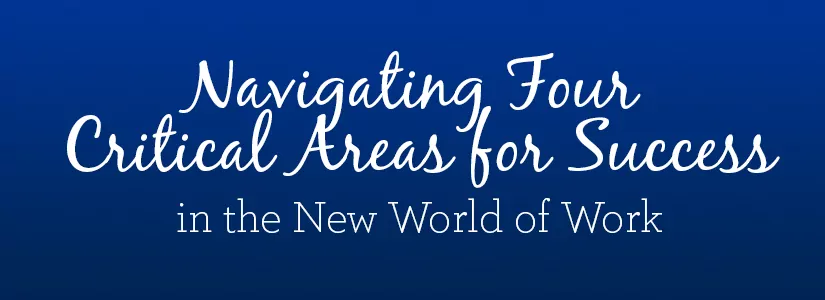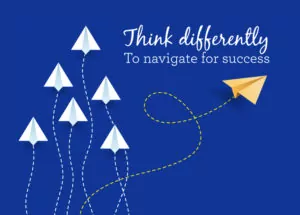- April 13, 2021
- Posted by: Hillary Feder
- Category: Client Engagement, Employee Engagement, Engagement

Let’s face it: The last year was one we all wish we could forget.
But let’s not forget the growth that accompanied adversity. Let’s leverage it to prepare for meaningful personal and professional change. Ready to start the hard work?
I am, and I’ve heard from a great many of you that the pandemic has opened a portal to a new world of work. I‘m hearing about the actions people are taking and their thoughts about what’s next. While there’s a wide range of ideas, optimism, and concerns, most are ready for change.
I know this because you’ve told me you are ready to stir up some positive change. I’ve heard from you in one way or another that the pandemic is proving to be a portal to a new world of work. I listened to the actions people are taking and their thoughts for what’s next. What I heard included a wide range of ideas, optimism and some concerns – but everyone is ready for change.
There are four prevailing universal themes for navigating change:
- leading in times of change
- communication
- creating connections
- hyper-awareness of well-being (physically, emotionally, cognitively, behaviorally).
While preparing for what’s next, keep in mind your company’s resilience begins with your people’s resilience. Each employee, customer, and partner has emerged change-ready from this pandemic, so I want to share some ideas to help you engage your team and create a work experience that reflects your culture.
Leading through change – “see it, solve it”
Leaders are making plans for returning to the office, which in most cases is likely to involve a hybrid approach that will require adaptation. Leaders should model the behaviors they expect and energize their teams. It’s a delicate balancing act—being visibly human and vulnerable while earning respect for leadership.
Leaders who engage in personal conversations inspire employees to reconnect with each other, engage and move forward together. Leaders at all levels who demonstrate authenticity in understanding what their teams are experiencing professionally and personally will prevent negative emotions from festering and will establish new habits that foster connectedness.
Communicating to the “last mile”
What’s ahead will require a micro-communication plan that solves the “last mile” challenge. What is the “last mile” challenge? It is the need to ensure that what is communicated is actually heard and processed by your team. Consider putting together a communication planning team with divergent pandemic experiences that holistically represent your workforce. Your plan should include both high-level messages and a more detailed tactical plan with the following elements:
- Clarity about what’s next, why it’s important and where they can turn to for help.
- Communicate the same message multiple ways, multiple times through multiple channels.
- Communicate with an extraordinary dose of empathy, compassion and openness that empowers people to speak up when things aren’t right.
- Fueling a culture of curiosity that empowers managers to ask straight forward open-ended questions to understand how their team is really doing. Example: “What’s the most difficult thing you’ve experienced today/lately?”
- Communicate safety and well-being as a priority. Many may be overwhelmed navigating different challenges: their own health, caring for others, how they get to work, feeling pressure to deliver at work and at home. Do what is necessary to bring physical and psychological safety for teams to perform well.
Creating connections and “making the magic happen”
Thirteen months ago, all non-essential businesses were forced to become digitally-enabled. Working from home (WFH) has had it’s advantages: fewer interruptions, greater autonomy, no commute, even some productivity gains. At the same time, the #1 challenge felt by many organizations has been the erosion of their internal culture–softening relationships due to the absence of water cooler conversation and the dwindling sense of belonging to a community and team.
As we exit the pandemic, it’s important to focus on rekindling engagement in a hybrid work environment to create the kind of client experience you want. Consider these ideas:
- Break down what you want to achieve into micro-steps that are too small to fail. Start where you are and build them to where you want to go.
- People crave and need the human connection, yet more than 60% (according to a PwC survey) would prefer a balance of WFH and in the office. Understand the times that need to be preserved to keep teams together, and create standards and expectations.
- Magical moments that bring people together include: collaboration, brainstorming, specific project work and celebration which lead to deepening relationships and trust.
- Keep a list of people you have not personally connected with recently. Block an hour daily to connect by phone, email, text, use the approach that you think works best for that person. Use this time to find out how they’re doing personally and professionally. Make good notes, so when you circle back you can reengage where you left off. When done with heart, your endorphins will fire and you will both have a huge smile.
- Fuel momentum and innovation digitally through evolving software platforms, from virtual reality to video conferencing.
- Examine each individual role for needs and resources required to design a balance of WFH and office. Plan accordingly, one size does not fit all.
Well-being – it’s a learnable skill
With people stretched physically, emotionally, cognitively, and behaviorally, creativity, innovation, and empathy seem unattainable. Well-being is learnable. When you care for your people, business outcomes will follow. Ideas to create conditions for your team’s well-being:
- Encourage deep breathing, the single most important practice to manage stress and enable one to recharge and engage. Encourage people to take a few minutes, several times a day to breathe deeply and quiet the mind.
- Encourage people to leave perfectionism at the door and give themselves some grace.
- Set the example and encourage others to manage relationships with digital devices. Also encourage setting aside time to unplug and find solitude. Arianna Huffington said it best, “We’re not machines — unlike our devices, we can only recharge when we’re unplugged.
- Support managers with tips for recognizing when someone is feeling overwhelmed and how to respond. One awesome resource: the healthy minds app.
- Support those truly struggling with their emotional well-being; consider policies and benefits that support self-care.
- Gratitude is an anecdote to anxiety. Encourage your team to take advantage of activities that do not require the brain (washing your hands, making a bed, loading the dishwasher) and use that time to think of things you are grateful for. Practicing gratitude is one of the easiest methods to increase feelings of optimism.
When individuals thrive, organizations thrive. Prioritize agility and resilience to respond to a rapidly changing work environment over following “a concrete plan”.
As always, I love learning from you. Please drop me a note or give me a call 952-933-8365 to let me know how you and your team are working through today’s changing environment. I truly enjoy connecting with colleagues.
If you need outside resources to guide you to enhanced communication, connectivity, and well-being that boost your employees’ experience, let’s start a conversation. You don’t have to go it alone.

